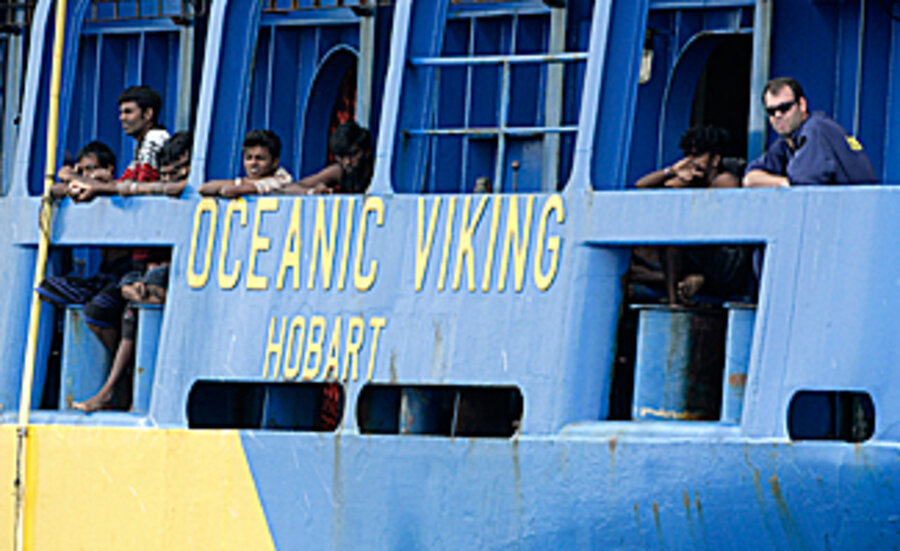Rising tide of asylum-seekers: Will Australia let them in?
Loading...
| Sydney, Australia
It is the enduring image of the John Howard era: special-forces troops boarding a Norwegian freighter, the Tampa, to prevent it from docking in Australia with 430 asylum-seekers rescued from their sinking boat. The 2001 incident sparked international condemnation but it helped the conservative prime minister to win his third general election.
Now Howard's Labor successor, Prime Minister Kevin Rudd – who must call an election within the next 12 months – has his own Tampa: the Oceanic Viking, an Australian customs ship that picked up 78 Sri Lankan Tamils from a stricken vessel in Indonesia's search-and-rescue zone nearly a fortnight ago. Mr. Rudd has persuaded Indonesia to take in the asylum-seekers, but they were still refusing to disembark Friday, after five days anchored off the northern port of Kijang.
Meanwhile, another 255 Tamils intercepted by the Indonesian Navy en route to Australia have spent nearly three weeks in the port of Merak, in West Java. They too, are refusing to get off. They too, want to go to Australia, rather than being processed in an Indonesian detention center and then waiting, probably for years, to be resettled in another country.
The twin standoffs come amid a sudden increase in the number of asylum-seekers heading to Australia, often in rickety boats after having paid unscrupulous "people-smugglers." And they are proving a serious test for Rudd's government, which is facing criticism across the political spectrum for either opening the door to human smuggling or shirking responsibility on a humanitarian issue.
'Indonesian solution' on 'boat people'
The Rudd government sees Indonesia, the main transit point for the voyage to Australia, as the key to tackling the problem. Last week, the sprawling archipelago to Australia's north agreed to play a bigger part in intercepting and accommodating "boat people" in exchange for fina0ncial assistance reported to amount to tens of millions of dollars.
The Australian media is calling it the "Indonesian Solution": a reference to the so-called "Pacific Solution," which Howard thought up to resolve the Tampa crisis. The Tampa's mainly Afghan passengers, along with successive boatloads of would-be migrants, were shipped to the impoverished Pacific nations of Papua New Guinea and Nauru, where they were processed by United Nations refugee officials, without access to the Australian legal system.
One of Rudd's first acts after being elected two years ago was to scrap the widely reviled "Pacific Solution," together with certain other hard-line policies, including "temporary protection visas," which entitled refugees to remain in Australia for only three years.
Others he retained, notably the policy of "excising" offshore Australian islands from the country's migration zone. Asylum-seekers who reach Australian waters are taken to Christmas Island, a remote Australian territory in the Indian Ocean. Many, including some children, are kept in detention.
Now Rudd is under fire from both left and right: conservatives, including opposition politicians, claim his policies have "rolled out the red carpet to people-smugglers," while those on the left accuse him of offloading responsibility on to Indonesia. The use of Christmas Island – bursting at the seams following the arrival of 34 boats carrying about 1,700 people this year, the largest number for seven years – has been denounced by the Australian Human Rights Commission.
Australian opinion
Public opinion, meanwhile, is divided. A recent poll by the Lowy Institute for International Policy found that three-quarters of Australians are concerned about the rising number of asylum-seekers, who come mainly from Afghanistan, Iraq, and Sri Lanka. But the debate, while lively, does not have the same stridency as in 2001, and has not harmed Rudd's popularity.
David Manne, of the Melbourne-based Refugee and Immigration Legal Centre, says "push factors" such as the end of the civil war in Sri Lanka – rather than more lenient government policies – are responsible for the spike in asylum-seekers. He points out that it is a global phenomenon, with Europe and other destinations also witnessing an increase.
Australia, he says, has been pursuing a policy for some years of persuading Indonesia and also Malaysia to "warehouse" asylum-seekers. "One of the fundamental problems is that these countries are not signatories to the UN Refugee Convention. They have very poor human rights records, particularly in relation to their treatment of refugees, and have even at times deported people back to their homeland."
In Indonesia, says Mr. Manne, refugees are detained "in appalling, dangerous, often prisonlike conditions" while they wait, sometimes for up to nine years, to be resettled.
Graham Thom, refugee coordinator for Amnesty International Australia, says the numbers of people seeking asylum here are still tiny. "They've gone from nothing to very few, so it's hard to argue that we're being swamped or overrun."
Rudd has not ruled out the use of force to remove the Tamils from the Oceanic Viking and transport them to a detention center on Bintan island. But local officials are lukewarm about the Indonesian Solution. The provincial governor, Ismeth Abdullah, said this week: "We're not a dumping ground for other countries."





